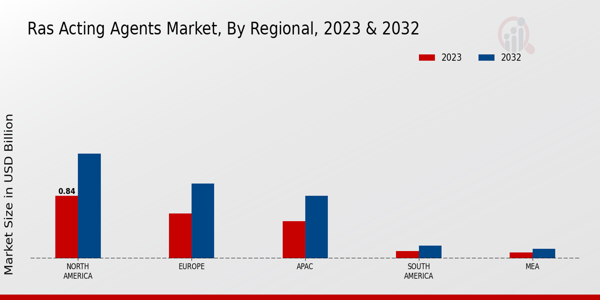Rising Geriatric Population
The increasing geriatric population is a significant factor driving the RAS-Acting Agents Market. Older adults are more susceptible to chronic conditions such as hypertension and heart failure, which often necessitate the use of RAS-acting agents for effective management. As the global population ages, the demand for these therapeutic agents is expected to rise correspondingly. Data indicates that by 2030, the number of individuals aged 65 and older will reach approximately 1.4 billion, further emphasizing the need for targeted treatments. This demographic shift presents a lucrative opportunity for pharmaceutical companies to develop and market RAS-acting agents tailored to the unique needs of older patients, potentially enhancing their market share.
Growing Focus on Preventive Healthcare
The shift towards preventive healthcare is emerging as a crucial driver for the RAS-Acting Agents Market. As healthcare systems worldwide emphasize prevention over treatment, there is an increasing recognition of the role that RAS-acting agents can play in managing risk factors associated with cardiovascular diseases. Preventive strategies often include the use of medications to control blood pressure and reduce the risk of heart failure, thereby creating a robust market for RAS-acting agents. Furthermore, public health initiatives aimed at educating populations about the importance of cardiovascular health may lead to higher adoption rates of these agents. This trend suggests that the market for RAS-acting agents could expand as healthcare providers increasingly recommend them as part of comprehensive preventive care plans.
Regulatory Support for Innovative Therapies
Regulatory bodies are increasingly supporting the development of innovative therapies, which is likely to benefit the RAS-Acting Agents Market. Initiatives aimed at expediting the approval process for new drugs can facilitate quicker access to novel RAS-acting agents. This regulatory environment encourages pharmaceutical companies to invest in research and development, knowing that their innovative products may receive faster market entry. Additionally, the establishment of clear guidelines for the evaluation of new therapies can enhance the confidence of investors and stakeholders in the RAS-acting agents sector. As a result, the market may witness an influx of new products, catering to the diverse needs of patients with conditions related to the renin-angiotensin system.
Advancements in Drug Development Technologies
Technological advancements in drug development are significantly influencing the RAS-Acting Agents Market. Innovations such as high-throughput screening and computational drug design are expediting the discovery of new RAS-acting agents. These technologies enable researchers to identify potential drug candidates more efficiently, reducing the time and cost associated with bringing new therapies to market. As a result, pharmaceutical companies are likely to enhance their pipelines with novel RAS-acting agents, catering to the growing demand for effective treatments. Moreover, the integration of artificial intelligence in drug development processes may further streamline the identification of promising compounds, potentially leading to breakthroughs in the management of diseases related to the renin-angiotensin system.
Increasing Prevalence of Cardiovascular Diseases
The rising incidence of cardiovascular diseases is a primary driver for the RAS-Acting Agents Market. As conditions such as hypertension and heart failure become more prevalent, the demand for effective therapeutic agents that target the renin-angiotensin system is likely to increase. According to recent data, cardiovascular diseases account for a substantial portion of global mortality, prompting healthcare systems to prioritize innovative treatments. This trend suggests that pharmaceutical companies may invest more in research and development of RAS-acting agents, potentially leading to a wider array of treatment options. Furthermore, the increasing awareness of cardiovascular health among the population may drive patients to seek medical advice, thereby boosting the market for RAS-acting agents.


















Leave a Comment